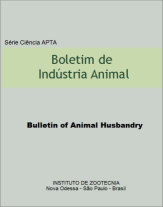Genetic parameter for meat fatty acid profile of Nelore cattle finished in feedlot
Palabras clave:
Bos indicus, fatty acid composition, genetic variabilityResumen
The aim of this study was to estimate (co)variance components and genetic parameters (heritability and genetic correlations) for meat fatty acid composition in Nellore cattle. The fatty acids analyzed were: conjugated linoleic acid - CLA (C18:2 trans-10 cis-12), palmitic acid (C16:0), stearic acid (C18:0), oleic acid (C18:1 cis-9), linoleic acid (C18:2 cis- 9-12) and linolenic acid (C18:3). A total of 751 Nellore bulls, finished in feedlot for at least 90 days, with average age at slaughter of 24 months were used. The animals belong to eight farms located in the Southeast, Northeast and Midwest regions, of São Paulo State, which comprise three specific genetic breeding programs. The fatty acid determination was carried out at the Laboratory of Meat Science (LCC), Department of Animal Production and Nutrition FMVZ/USP. Samples from theLongissimus muscle were collected 48 hours after slaughter. The determination of meat fatty acid profile was performed by the method of Folch et al. (1957) and Kramer et al. (1997). Fatty acids were quantified by gas chromatography (GC-2010 Plus - Shimadzu AOC 20i auto sampler) using SP-2560 capillary column (100 m × 0.25 mm in diameter with 0.02 mm thickness, Supelco, Bellefonte, PA). To estimate the (co) variance components and genetic parameters, the model included the additive genetic effect as random effect, and the fixed effects of the contemporary group and animal's age at slaughter as a covariable (linear effect). The model used for the estimation of the included random direct genetic effect, the fixed effect of the GC, and the animal's age at slaughter as a covariate (linear effect).The (co)variance components and genetic parameters were estimated by Bayesian inference with a linear multi-trait animal model, using the GIBBS2F90 program. The convergence of the data was verified using the R software package analyzed with the Bayesian Output Analysis (BOA) of the R 2.9.0 software (The R Development Core Team, 2009). Heritability estimates obtained for the fatty acids analyzed were: 0.52; 0.26; 0.68; 0.57; 0.46 and 0.41 for CLA, palmitic acid, stearic acid, oleic acid, linoleic acid and linolenic acid, respectively. The genetic correlation estimates between the palmitic acid (C16: 0) with stearic acid, oleic acid, linoleic acid, linolenic acid and CLA showed the following values: 0.14; 0.39; -0.09; -0.33; 0.34. The genetic correlation estimates between the stearic acid with oleic acid, linoleic acid, linolenic acid and CLA were 0.24, -0.06, -0.21 and 0.22, respectively. For the oleic acid, the genetic correlation estimates were -0.04, -0.02 and -0.02, with the linoleic acid, linolenic acid and CLA, respectively. The genetic correlation estimated between the linolenic acid and CLA was close to zero. Most of the genetic correlations estimates between fatty acids were low to moderate. The heritability estimates for fatty acids were moderate to high, indicating that these traits would respond rapidly to selection. The genetic correlation estimates between fatty acids with different degrees of saturation suggest that indirect selection to improve the meat fatty acid composition is possible.Descargas
Descargas
Publicado
Número
Sección
Licencia
Os autores não serão remunerados pela publicação de trabalhos, pois devem abrir mão de seus direitos autorais em favor deste periódico. Por outro lado, os autores ficam autorizados a publicar seus artigos, simultaneamente, em repositórios da instituição de sua origem, desde que citada a fonte da publicação original seja Boletim de Indústria Animal. A revista se reserva o direito de efetuar, nos originais, alterações de ordem normativa, ortográfica e gramatical, com vistas a manter o padrão culto da língua e a credibilidade do veículo. Respeitará, no entanto, o estilo de escrever dos autores. Alterações, correções ou sugestões de ordem conceitual serão encaminhadas aos autores, quando necessário. Nesses casos, os artigos, depois de adequados, deverão ser submetidos a nova apreciação. As opiniões emitidas pelos autores dos artigos são de sua exclusiva responsabilidade. Todo o conteúdo deste periódico, exceto onde está identificado, está licenciado sob a Licença Creative Commons Attribution (CC-BY-NC). A condição BY implica que os licenciados podem copiar, distribuir, exibir e executar a obra e fazer trabalhos derivados com base em que só se dão o autor ou licenciante os créditos na forma especificada por estes. A cláusula NC significa que os licenciados podem copiar, distribuir, exibir e executar a obra e fazer trabalhos derivados com base apenas para fins não comerciais.













